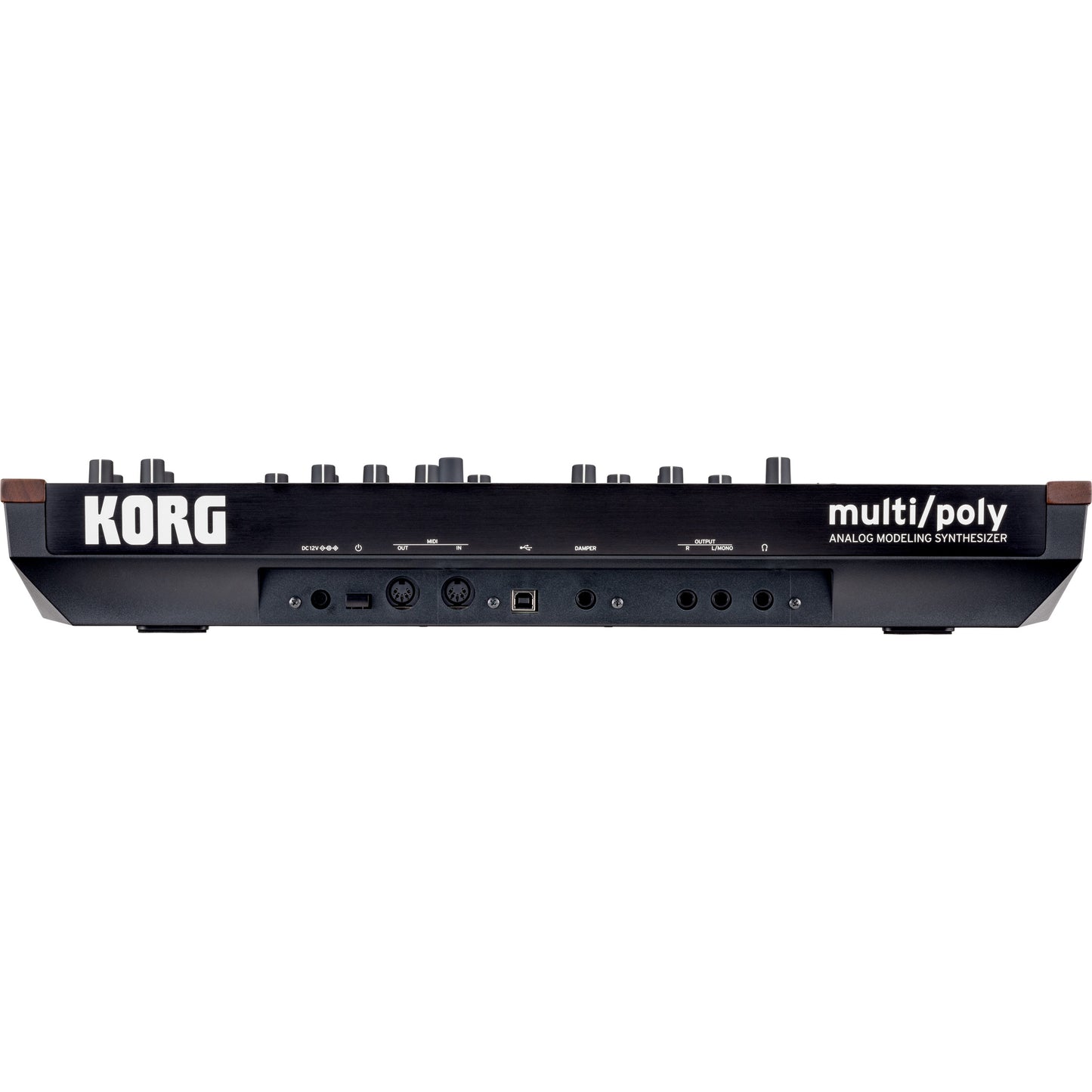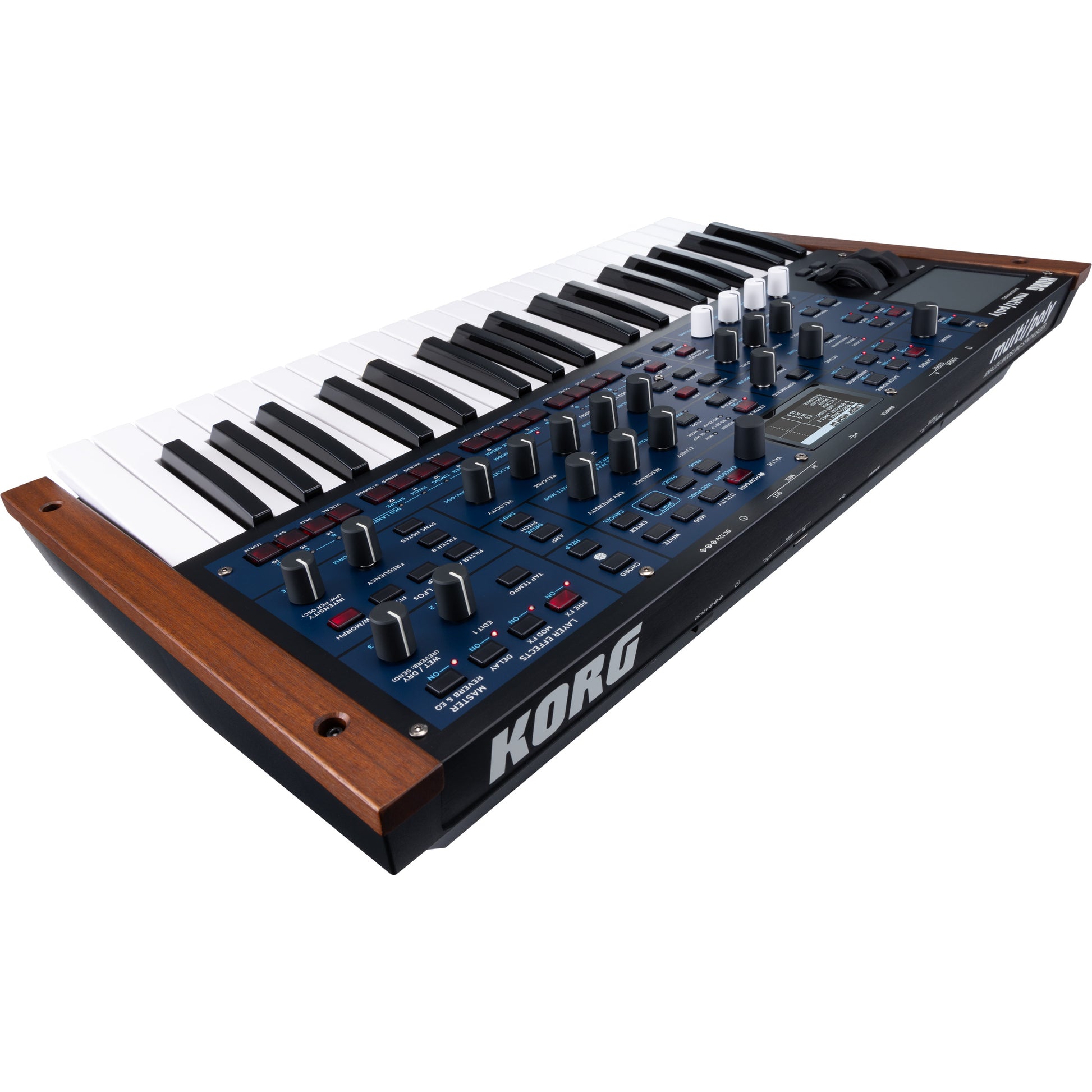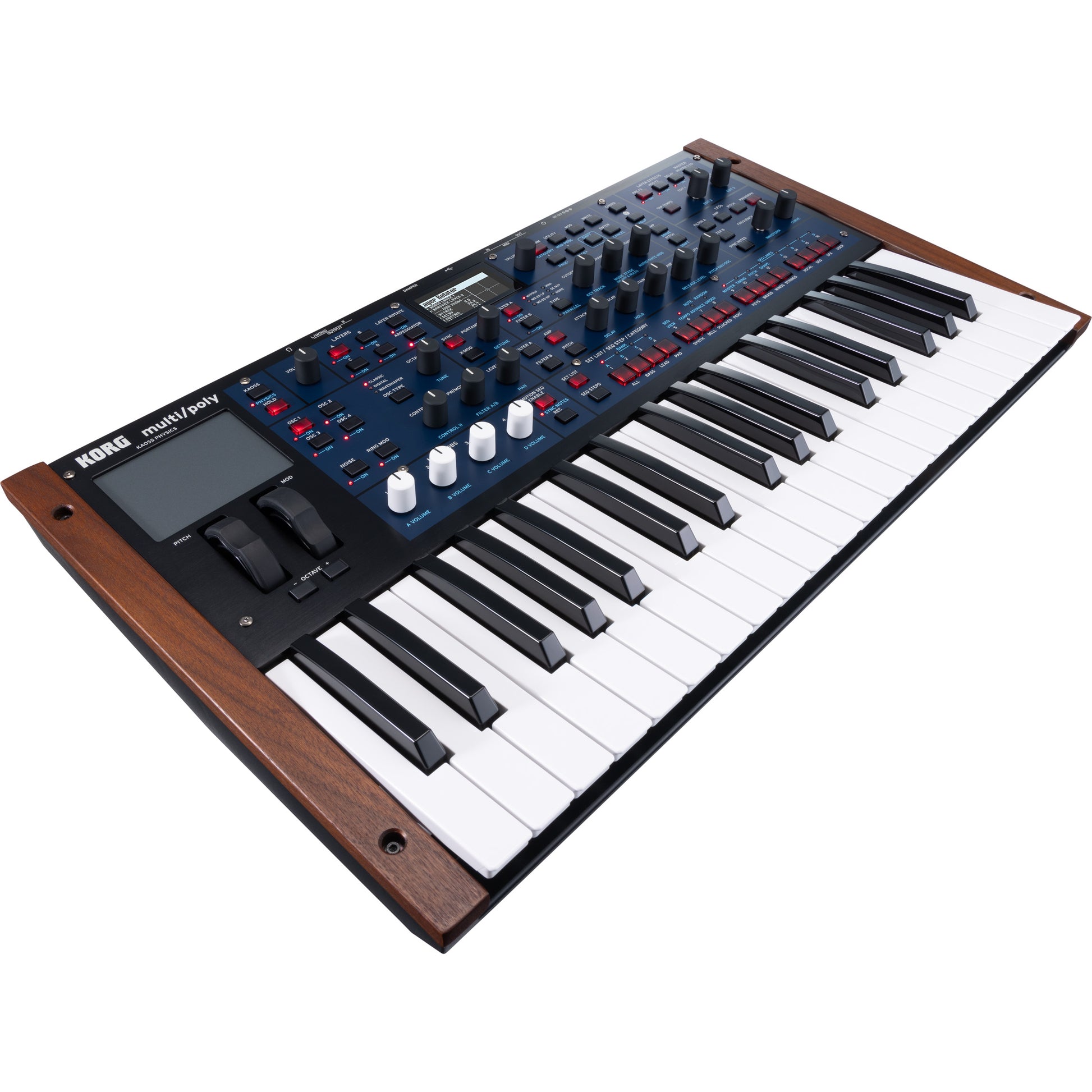





- Details
- Features
- Reviews
Amazing analog sounds that only digital can provide
Inspired by the legendary KORG Mono/Poly, the new KORG multi/poly analog modeling synthesizer delivers breathtaking analog sounds combined with extraordinary digital power and flexibility.
The original Mono/Poly boasted an unusually rich sound from its four stacked oscillators, as well as unique, experimental features like flexible x-mod and sync routing and round-robin oscillator triggering. Previously only attainable in large modular systems, the Mono/Poly delivered these features in a compact, user-friendly instrument.
The new multi/poly is the first instrument to use KORG's next-generation analog modeling technology and builds on that legendary distinctive combination of big sounds and modular-derived experimental features. It's like a polyphonic modular system in a compact, hands-on package – a limitless playground for synth players and sound designers. Create hardware mash-ups with East-coast, West-coast, and wavetable oscillators and a wide selection of newly-modeled filters. Make them come alive with models of different envelope, VCA, and portamento circuits. Virtual voice cards produce organic timbral variation. Layer Rotate triggers new Programs with each press of a key. Plus Kaoss Physics, Motion Sequencing 2.0, massive modulation, and more.
Next-level analog modeling
The multi/poly features redesigned, incredible-sounding filters and oscillators – and its advances in analog modeling go so much deeper. To start with, each voice has a Virtual Voice Card whose oscillators, filters, envelopes, LFOs, and portamento circuits model analog hardware component variations. The result is that each voice has a slightly different character, creating naturally rich timbres. Dial in as much or as little of this variation as you like, separately for each sound.
Just like in an analog synth, voice cards also continue to play even if you're not hearing them. Envelopes keep evolving, so that if you play a pad with a long release time, newly played notes "catch" the envelope at its current level instead of restarting from zero. Oscillators and LFOs maintain their phase, and resonance continues to ring. Each oscillator’s pitch can also drift slightly over time, modeling the slight pitch instabilities found in analog hardware.
Envelopes are an often-overlooked factor that contributes to the unique sounds of vintage synths. The multi/poly includes envelope curvature presets for the Mono/Poly, MS-20, "Mini," "Pro," ARP Odyssey, and more. Also, analog VCAs don’t respond evenly to voltage, and have different thresholds for turning on and off, which in turn has a strong effect on the Amp Envelope's character. So, the multi/poly features modeled VCA responses from the Mono/Poly, MS-20, Mini, Odyssey, and Prophet 5, as well as a linear option.
Ever tried to re-create a portamento effect from a favorite song, but couldn't find the right setting even when you switched between "constant rate" and "constant time?" Classic analog synths had different approaches to portamento, too, and so the multi/poly has six different portamento models to choose from.
Oscillators
The multi/poly offers FOUR oscillators per Program, for unusually thick, complex tones. Each can use the Classic, Digital, or Waveshaper oscillator types. The Classic oscillator models traditional analog synth oscillators with stunning fidelity and effortless thickness. 11 options include both single and dual waveforms, for modeling synths that generated multiple waveforms at once. Front panel knobs give you hands-on control of pulse width, triangle "lean", dual-waveform blend, and more.
The Digital oscillator plays wavetables with up to 64 steps, like vintage hybrid synths and modern eurorack modules. Start with over 200 factory wavetables, or load your own using the Editor/Librarian software for macOS and Windows. Import modwave wavetables directly, or convert wavetables from popular software formats. Use the 30+ Modifiers to change the way that the tables are loaded, resulting in subtle to extreme changes in timbre, and 8 Morph Types like Stretch, Flip, and Mirror to process them in real-time.
Waveshaper offers a "West-Coast" approach, in which simple waveforms (sine or triangle) are processed through a shaper table. Modulating gain into the shaper creates glassy, dynamic harmonics. Use the Berkeley shaper for traditional wavefolder timbres, or select from over 90 other shaper types. The multi/poly also adds modulatable pulse width, a unique twist, for another dimension of richness and motion.
In addition to oscillators 1-4, there's a separate noise generator with dedicated filtering and saturation, and a ring modulator with inputs from all of the above.
The multi/poly also expands on the original Mono/Poly's powerful oscillator sync and x-mod capabilities, for timbres otherwise only possible with a large modular setup. Create unique sounds with Oscillators 2, 3, and 4 simultaneously following Oscillator 1 for sync, x-mod, or both at once. Alternatively, split either function into oscillator pairs with separate control.
Dual modeled filters
All of the multi/poly's filters are newly redesigned, including an amazing suite of vintage filters with authentic euphonic saturation. To start with, there are five different 4-pole self-resonating models. M/Poly provides the strong, sweet sound of the classic Korg Mono/Poly. Mini is the ladder filter from a beloved American mono-synth; resonance is reduced at low frequencies, critical for producing those classic bass sounds. Pro is from the first programmable polyphonic synthesizer, with strong resonant sweeps all the way down. Finally, Ladder HP and BP are 4-pole self-resonating highpass and bandpass filters, respectively.
The MS-20 LP and HP 12dB/octave self-resonating "Korg 35" filters lovingly recreate the distinctive, aggressive timbral signature of the classic Korg MS-20. The SE M/P 2-pole filter is more gentle in character, and features a continuous control to sweep between lowpass, band reject, and highpass, plus a separate bandpass mode.
You can also shape and refine with a full collection of linear, resonant 2-pole and 4-pole lowpass, highpass, bandpass, and band reject filters. Or, step outside the box with KORG’s unique Multi Filter, which creates modulatable blends of multiple modes simultaneously.
All of these filters support audio-rate modulation for ear-catching bright, fizzy, and bubbling effects. Use any of the oscillators or the ring modulator as the modulation source, and even blend in the noise generator for more chaotic timbres. In addition to the vintage filters' built-in saturation, a post-filter anti-aliased Drive circuit lets you add more weight and grit to taste, from subtle thickening to heavy distortion.
Finally, you can use any two of these filters simultaneously, in series or in parallel. Programs have two filter slots, A and B. Each source, including the four oscillators, noise, and ring Mod, has a balance control which crossfades between the two filters–enabling a wide array of creative options. For instance, send one group of oscillators through the M/Poly filter, and the other through the MS-20 lowpass. Create a classic highpass->lowpass serial chain, but route one or more oscillators around the highpass. Since this is a continuous crossfade, and not just a switch, you can modulate the A/B Balance for unique effects. The filters can also run in stereo, with separate panning for each of the sources.
| Product Name | Korg Multipoly Analog Modeling Synthesizer |
|---|---|
| Brand | Korg |
| Condition | New |
| MPN | MULTIPOLY |
| UPC | 4959112245433 |
| Shipping Option | Free Shipping to the Continental U.S. |
What's in the Box?
- Korg Multipoly Analog Modeling Synthesizer
- AC adapter
- Precautions
- Quick Start Guide
- Create hardware mash-ups with classic analog, digital wavetable, and wave-shaper oscillators, a selection of next-generation modeled filters, modeled portamento, modeled envelopes, and modeled VCAs.
- Programs include four oscillators, a noise generator, dual filters, and three insert effects, plus a massively flexible modulation system with four looping DAHDSR envelopes, five LFOs, six Mod Processors, three key-track generators, and multi-lane Motion Sequencing 2.0.
- Performances layer four Programs at once, adding master reverb & EQ, another two Mod Processors, and Kaoss Physics.
- Layer Rotate triggers new Programs with each press of a key.
- Motion Sequencing 2.0 runs individual sequences for each voice. Easily record knob movements in real-time. Timing, Pitch, Shape, and four sets of Step Sequence values are separated into “lanes.” Each lane can have a different number of steps. Modulate loop points, step probabilities, and more on a per-note basis.
- Kaoss Physics combines hands-on modulation control with interactive game-style physics including gravity, reflection, absorption, and friction.
- Mod Knobs make it easy to control sounds and make them your own.
- Smooth Sound Transitions let previously-played voices and effects ring out naturally when you change sounds.
Korg Multipoly Analog Modeling Synthesizer
Amazing analog sounds that only digital can provide
Inspired by the legendary KORG Mono/Poly, the new KORG multi/poly analog modeling synthesizer delivers breathtaking analog sounds combined with extraordinary digital power and flexibility.
The original Mono/Poly boasted an unusually rich sound from its four stacked oscillators, as well as unique, experimental features like flexible x-mod and sync routing and round-robin oscillator triggering. Previously only attainable in large modular systems, the Mono/Poly delivered these features in a compact, user-friendly instrument.
The new multi/poly is the first instrument to use KORG's next-generation analog modeling technology and builds on that legendary distinctive combination of big sounds and modular-derived experimental features. It's like a polyphonic modular system in a compact, hands-on package – a limitless playground for synth players and sound designers. Create hardware mash-ups with East-coast, West-coast, and wavetable oscillators and a wide selection of newly-modeled filters. Make them come alive with models of different envelope, VCA, and portamento circuits. Virtual voice cards produce organic timbral variation. Layer Rotate triggers new Programs with each press of a key. Plus Kaoss Physics, Motion Sequencing 2.0, massive modulation, and more.
Next-level analog modeling
The multi/poly features redesigned, incredible-sounding filters and oscillators – and its advances in analog modeling go so much deeper. To start with, each voice has a Virtual Voice Card whose oscillators, filters, envelopes, LFOs, and portamento circuits model analog hardware component variations. The result is that each voice has a slightly different character, creating naturally rich timbres. Dial in as much or as little of this variation as you like, separately for each sound.
Just like in an analog synth, voice cards also continue to play even if you're not hearing them. Envelopes keep evolving, so that if you play a pad with a long release time, newly played notes "catch" the envelope at its current level instead of restarting from zero. Oscillators and LFOs maintain their phase, and resonance continues to ring. Each oscillator’s pitch can also drift slightly over time, modeling the slight pitch instabilities found in analog hardware.
Envelopes are an often-overlooked factor that contributes to the unique sounds of vintage synths. The multi/poly includes envelope curvature presets for the Mono/Poly, MS-20, "Mini," "Pro," ARP Odyssey, and more. Also, analog VCAs don’t respond evenly to voltage, and have different thresholds for turning on and off, which in turn has a strong effect on the Amp Envelope's character. So, the multi/poly features modeled VCA responses from the Mono/Poly, MS-20, Mini, Odyssey, and Prophet 5, as well as a linear option.
Ever tried to re-create a portamento effect from a favorite song, but couldn't find the right setting even when you switched between "constant rate" and "constant time?" Classic analog synths had different approaches to portamento, too, and so the multi/poly has six different portamento models to choose from.
Oscillators
The multi/poly offers FOUR oscillators per Program, for unusually thick, complex tones. Each can use the Classic, Digital, or Waveshaper oscillator types. The Classic oscillator models traditional analog synth oscillators with stunning fidelity and effortless thickness. 11 options include both single and dual waveforms, for modeling synths that generated multiple waveforms at once. Front panel knobs give you hands-on control of pulse width, triangle "lean", dual-waveform blend, and more.
The Digital oscillator plays wavetables with up to 64 steps, like vintage hybrid synths and modern eurorack modules. Start with over 200 factory wavetables, or load your own using the Editor/Librarian software for macOS and Windows. Import modwave wavetables directly, or convert wavetables from popular software formats. Use the 30+ Modifiers to change the way that the tables are loaded, resulting in subtle to extreme changes in timbre, and 8 Morph Types like Stretch, Flip, and Mirror to process them in real-time.
Waveshaper offers a "West-Coast" approach, in which simple waveforms (sine or triangle) are processed through a shaper table. Modulating gain into the shaper creates glassy, dynamic harmonics. Use the Berkeley shaper for traditional wavefolder timbres, or select from over 90 other shaper types. The multi/poly also adds modulatable pulse width, a unique twist, for another dimension of richness and motion.
In addition to oscillators 1-4, there's a separate noise generator with dedicated filtering and saturation, and a ring modulator with inputs from all of the above.
The multi/poly also expands on the original Mono/Poly's powerful oscillator sync and x-mod capabilities, for timbres otherwise only possible with a large modular setup. Create unique sounds with Oscillators 2, 3, and 4 simultaneously following Oscillator 1 for sync, x-mod, or both at once. Alternatively, split either function into oscillator pairs with separate control.
Dual modeled filters
All of the multi/poly's filters are newly redesigned, including an amazing suite of vintage filters with authentic euphonic saturation. To start with, there are five different 4-pole self-resonating models. M/Poly provides the strong, sweet sound of the classic Korg Mono/Poly. Mini is the ladder filter from a beloved American mono-synth; resonance is reduced at low frequencies, critical for producing those classic bass sounds. Pro is from the first programmable polyphonic synthesizer, with strong resonant sweeps all the way down. Finally, Ladder HP and BP are 4-pole self-resonating highpass and bandpass filters, respectively.
The MS-20 LP and HP 12dB/octave self-resonating "Korg 35" filters lovingly recreate the distinctive, aggressive timbral signature of the classic Korg MS-20. The SE M/P 2-pole filter is more gentle in character, and features a continuous control to sweep between lowpass, band reject, and highpass, plus a separate bandpass mode.
You can also shape and refine with a full collection of linear, resonant 2-pole and 4-pole lowpass, highpass, bandpass, and band reject filters. Or, step outside the box with KORG’s unique Multi Filter, which creates modulatable blends of multiple modes simultaneously.
All of these filters support audio-rate modulation for ear-catching bright, fizzy, and bubbling effects. Use any of the oscillators or the ring modulator as the modulation source, and even blend in the noise generator for more chaotic timbres. In addition to the vintage filters' built-in saturation, a post-filter anti-aliased Drive circuit lets you add more weight and grit to taste, from subtle thickening to heavy distortion.
Finally, you can use any two of these filters simultaneously, in series or in parallel. Programs have two filter slots, A and B. Each source, including the four oscillators, noise, and ring Mod, has a balance control which crossfades between the two filters–enabling a wide array of creative options. For instance, send one group of oscillators through the M/Poly filter, and the other through the MS-20 lowpass. Create a classic highpass->lowpass serial chain, but route one or more oscillators around the highpass. Since this is a continuous crossfade, and not just a switch, you can modulate the A/B Balance for unique effects. The filters can also run in stereo, with separate panning for each of the sources.
| Product Name | Korg Multipoly Analog Modeling Synthesizer |
|---|---|
| Brand | Korg |
| Condition | New |
| MPN | MULTIPOLY |
| UPC | 4959112245433 |
| Shipping Option | Free Shipping to the Continental U.S. |
What's in the Box?
- Korg Multipoly Analog Modeling Synthesizer
- AC adapter
- Precautions
- Quick Start Guide
- Create hardware mash-ups with classic analog, digital wavetable, and wave-shaper oscillators, a selection of next-generation modeled filters, modeled portamento, modeled envelopes, and modeled VCAs.
- Programs include four oscillators, a noise generator, dual filters, and three insert effects, plus a massively flexible modulation system with four looping DAHDSR envelopes, five LFOs, six Mod Processors, three key-track generators, and multi-lane Motion Sequencing 2.0.
- Performances layer four Programs at once, adding master reverb & EQ, another two Mod Processors, and Kaoss Physics.
- Layer Rotate triggers new Programs with each press of a key.
- Motion Sequencing 2.0 runs individual sequences for each voice. Easily record knob movements in real-time. Timing, Pitch, Shape, and four sets of Step Sequence values are separated into “lanes.” Each lane can have a different number of steps. Modulate loop points, step probabilities, and more on a per-note basis.
- Kaoss Physics combines hands-on modulation control with interactive game-style physics including gravity, reflection, absorption, and friction.
- Mod Knobs make it easy to control sounds and make them your own.
- Smooth Sound Transitions let previously-played voices and effects ring out naturally when you change sounds.
- Choosing a selection results in a full page refresh.
- Opens in a new window.






